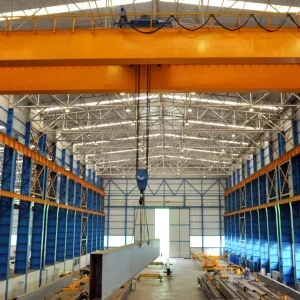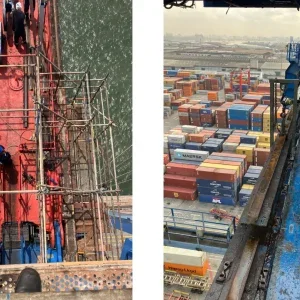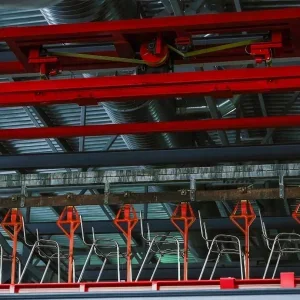While Hannover Fair was an international event showcasing the latest cutting-edge technologies, April’s NA 2000 exhibition in Detroit was a slightly lower key affair, but still drew the key movers and shakers of the North American materials handling industry.
This being Motor City, a lot of the equipment was aimed – at least in part – at automotive industries. But much of it was general materials handling and lift-ing equipment.
If there was any trend discernible at the show it was in the growth of ergonomic handling devices. Tawi, Gorbel, Ingersoll-Rand, Scaglia and Mannesmann Dematic were among those showing air-powered manipulators suspended from rails or gantries, crane-style.
Tawi has had an inverter control lifting device in Sweden for a year or more. In Detroit, Tawi USA showed its VacuMove, an air-powered vacuum lifting device designed for both lifting and holding loads in place. Gorbel used the show to introduce its G-Force device to the market, a lifter that allows the operator to lift and move up to 68kg with only the effort required to lift 1.4kg.
Tawi USA is a Gorbel distributor and showed its VacuMove suspended from a Gorbel rail.
Mannesmann Dematic’s overhead and through the air lifting equipment was almost lost among the conveyor belts of its Rapistan subsidiary. But alongside its Protomark lift assist was the new cable balancer and the DKVS chain hoist.
Ingersoll-Rand’s new pro-grammable electropneumatic hoist/handler was the star attraction of its display. This device, to be launched onto the market in July, has a microprocessor in it to detect what is being lifted. As a technology, air powered manipulators have been around for about 20 years. According to Ingersoll-Rand’s engineers, electropneumatic power is “the only new technology in the industry” and thus this unit – which we will look at in more detail in a future issue of this magazine – could claim to be the only wholly new piece of equipment at the show. The technology has come out of the University of California and been promoted by General Motors. The benefit of electropneumatic handling over straight air powered manipulators is that control is even smoother and more precise. The load stops exactly where your hand stops, with no over-run at all. At first sight, it appears truly impressive, but whether the technology can be priced at a level that the market will accept, and whether it proves reliable in harsh environments, will be determined in due course by the market. General Motors and Ford car plants have been putting prototypes through their paces for testing.
New to the North American market was the Toku/Yokota air-powered mini-hoist which has already been launched onto the European market by Yokota Europe and Red Rooster. In North America the Japanese-built hoist is marketed by Harrington Hoist, a subsidiary of Kito Corporation of Japan. Harrington brands this unit as the Mini-Cat work station air hoist.
Also on show were Tri-Motion Industries’ Bal-Trol air balancing hoists.
Much in evidence were modular rail systems, such as the Span- master Work Centres offered by TC/American Monorail.
Among the traditional crane companies such as R&M and Morris Material Handling, the presence of the UK’s Street Crane generated interest. Street, a first time exhibitor, has been campaigning in the North American market over the last two years and building commercial and technical alliances with leading regional crane makers such as O’Brien Materials Handling of Ontario. The show certainly proved successful as Street came away with orders worth $347,000 and a book full of new contacts. “We were staggered by the response,” said managing director Andrew Pimblett. “Visitors were genuinely interested to see our new ZX hoist.” The largest order taken by Street at the show, for $98,000 from O’Brien itself, was for hoists and travelling equipment for current contracts and stock. O’Brien is a crane builder and a distributor of Street’s hoists.
Street also gave a Michigan based crane maker a quotation for two 50t hoists with 10t auxiliaries and as a result got a $91,000 order.
“There were relatively few end users visiting the show,” said Pimblett, “but there were a lot of crane makers.” As these are the target audience of Street in North America, that was no bad thing.






